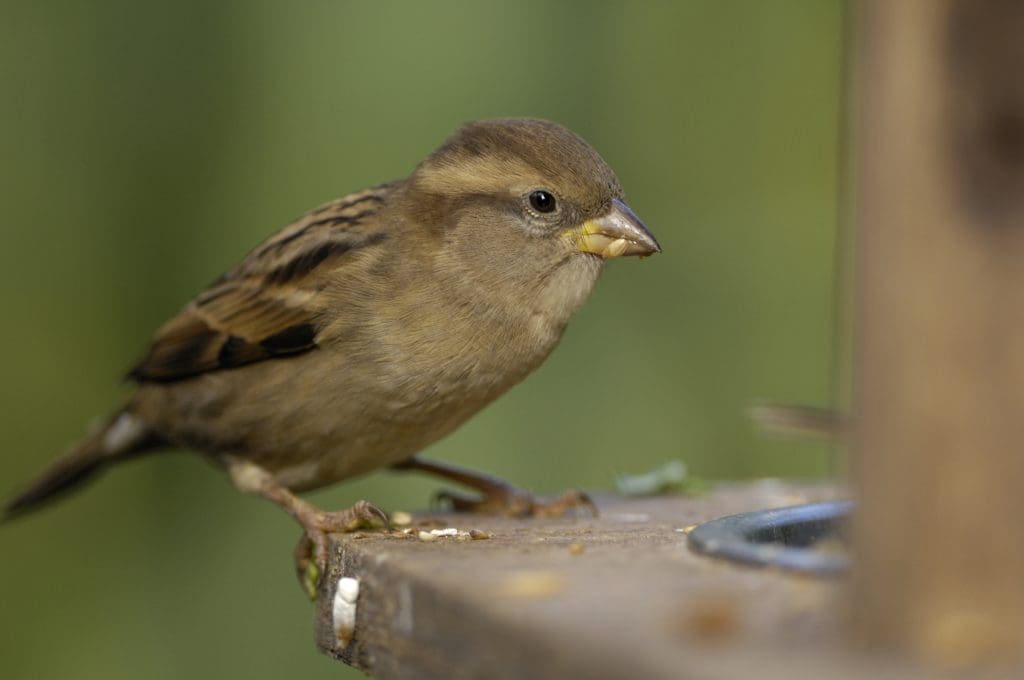- Over 40,000 people across the Scotland took part this year, counting more than 700,000 birds.
- House Sparrows retained the top spot for the fourteenth year running.
- The Big Garden Birdwatch is the world’s largest garden wildlife survey and the results highlight how our much-loved garden birds are faring and what you can do to help.
The results from this year’s Big Garden Birdwatch have revealed that House Sparrows have held on to the top spot in Scotland for the fourteenth year running, with Starlings at number two again and Blackbirds coming in at number three. Chaffinches and Blue Tits make up the remainder of the top five most recorded species.
Over 40,000 people in Scotland joined in the world’s largest garden wildlife survey counting more than 748,000 birds of nearly 50 species, once again highlighting the importance of our gardens for the nation’s wildlife. There were over 600,000 participants across the UK, counting a grand total of 9.5 million birds.
Director of RSPB Scotland Anne McCall said: “A huge thank you to everyone who took part in this year’s Big Garden Birdwatch, it is heartening that over 40,000 of us across Scotland joined in over the weekend, despite the challenging weather many of us faced with Storm Éowyn.
“There’s been no let-up in the decline of our wildlife over recent decades, with one in nine wildlife species at risk of being lost from Scotland.
“To halt this decline and turn round the current downward trajectory, we need to help wildlife return across the country and make it a natural feature of everyday life. Our gardens and community greenspaces provide the perfect place for us as individuals to start.
“Providing food, shelter and water for wildlife, not using chemicals and not using peat-based compost – what we do in our own backyard can make a huge difference. All of us making small changes can effect huge change.
“While our homes and gardens often provide the perfect place for individual people to help, we also urgently need governments and businesses to join us in the wider fight to restore our natural world”
Despite coming in at number two again in Scotland this year, across the whole of the UK we have seen the lowest number of Starlings ever recorded since Big Garden Birdwatch began in 1979.
Starlings are a red listed species in the UK and considered a high conservation concern due to their declining numbers. Scotland’s breeding population shows a 28.5% decline between 1995 and 2022.
These are medium-sized birds with glossy plumage that has a purple and green sheen, often with white spots during winter. They are also excellent mimics and can make a huge variety of tweets, cheeps and clicks. They can be found across the UK with their numbers swelling during winter when birds arrive from northern Europe, gathering together to perform spectacular murmurations.
Thankfully, there are ways to support these colourful, charming birds in our gardens. Avoiding the use of pesticides and keeping a natural lawn allows Starlings to forage for invertebrates, especially leatherjackets (cranefly larvae). They also need short grass to watch out for predators whilst feeding, so mowing the lawn now and again is beneficial. Putting up nest boxes also provides Starlings with a readymade nesting site and a box with a 45mm entrance hole is the ideal size for these birds.
The Big Garden Birdwatch is a large-scale citizen science survey that started in 1979, providing an annual snapshot of the status of garden birds in the UK. Participants are asked to count the maximum number of each species recorded at their chosen location (mainly gardens but also parks or other green spaces) during a one-hour period over the last weekend in January. Teachers and pupils can also take part in Big Schools’ Birdwatch, which reached over 100,000 participants across the UK this year for the first time ever.
Thanks to our members and supporters, the RSPB can carry out vital conservation efforts to support nature throughout the year. To find out the full Big Garden Birdwatch results, more about joining the RSPB, and all the ways you can help garden birds and other wildlife, visit: https://www.rspb.org.uk/whats-happening/big-garden-birdwatch
| Rank 2025 | Species | Average count per garden | % of gardens species recorded in 2025 | % change in % gardens recorded compared to 2024 |
| 1 | House Sparrow | 5.48 | 72.2 | 2.8% |
| 2 | Starling | 3.19 | 41.7 | 12.9% |
| 3 | Blackbird | 2.72 | 88.5 | 7.8% |
| 4 | Chaffinch | 2.52 | 48.7 | 1.0% |
| 5 | Blue Tit | 2.44 | 74.8 | -3.4% |
| 6 | Woodpigeon | 2.24 | 71.7 | 8.3% |
| 7 | Goldfinch | 1.74 | 30.5 | 16.0% |
| 8 | Robin | 1.70 | 90.1 | 3.9% |
| 9 | Great Tit | 1.26 | 49.6 | -8.8% |
| 10 | Feral Pigeon | 1.21 | 23.6 | 12.1% |
| 11 | Magpie | 1.19 | 48.8 | 4.3% |
| 12 | Coal Tit | 1.07 | 45.2 | -9.5% |
| 13 | Jackdaw | 1.02 | 28.5 | 13.2% |
| 14 | Carrion Crow | 0.93 | 33.1 | 0.2% |
| 15 | Dunnock | 0.84 | 42.7 | 4.6% |
| 16 | Long-tailed Tit | 0.81 | 17.5 | -12.4% |
| 17 | Collared Dove | 0.70 | 28.5 | 5.6% |
| 18 | Greenfinch | 0.44 | 16.5 | 3.4% |
| 19 | Wren | 0.25 | 20.2 | 3.4% |
| 20 | Siskin | 0.23 | 8.1 | 8.8% |

